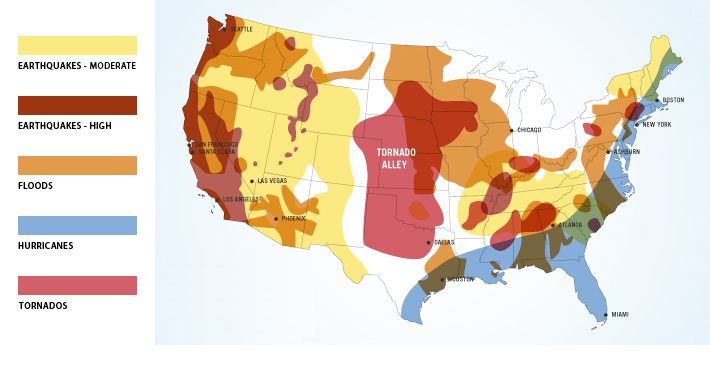Data Center Risk Factors and Recovery

What’s the biggest risk to a data center? Many facilities imply that fire is the biggest concern and highlight their fire suppression systems. Yet fire isn’t the only risk to a data center.
Data centers prepare a huge number of redundancies and protections – no matter how likely it is they will be needed.
This article will cover the types of risks that data centers typically prepare for, with a detailed look at:
- External risks: Natural disasters and supplier outages.
- Facility risks: infrastructure and risks involving the facility itself.
- Data system risks: Data management and architecture.
External Risks
External risks are those outside of a data center’s control. They include natural disasters, supplier outages, and human-caused events.
Natural Disasters
Many disaster recovery plans start by covering natural disasters, largely due to their potential damage being highest. Luckily, many meteorological threats can be forecasted before they become a problem and knowledgeable staff can be put on standby. This can mitigate a lot of the potential damage.
Large-scale damage and downtime from earthquakes and floods can be prevented with water penetration protection, a fire suppression system, and power backups. For a more detailed list of protections put in place, reach out to your hosting provider.
What if I Host in a Natural Disaster-Prone Area?
We understand that sometimes hosting in an area with frequent natural disasters is unavoidable. How you choose a data center is influenced by a number of different factors including proximity, convenience, and risk.
Most data center facilities located in such an area incorporate special infrastructure features, including reinforced buildings and stringent design plans. A good example is the Hostdedi Miami facility, which is Category 5 rated and designed to withstand flood damage and winds of up to 185 mph.
We highly recommend asking your facility about the history of natural disasters in their area and how they have affected the data center in the past. This will give you a good idea of what to expect and prepare for in the future.
As a rough guideline, the above map provides an overview of natural disaster frequency in the US. You can use this to identify susceptible areas.
Supplier Outages
Supplier outages occur when suppliers of either power, connectivity, or another important deliverable are unable to deliver. They are unavoidable but a suitably prepared data center can mitigate them entirely.
For example, downtime from a loss of connectivity or a downed power line is prevented by preparing multiple redundancies: additional power generators, multiple connections, and enough onsite fuel to last for several days.
It is important to have a backup pool of suppliers in the event one fails.
Facility Risks
There are seven main areas where you don’t want anything to go wrong in a data center facility: power, water, climate, structure, fire, communication, and security. These should all be incorporated in a disaster risk assessment.
Take a look below for a better idea of how and why each of these factors is important.
| Power | Disasters will likely cause a power outage. No power means no data center (at least one that works). Multiple power source availability means that a data center (and so your website) will stay online through the worst. |
| Water | Data centers are allergic to water. Even the smallest amount can cause a lot of damage. Water penetration protect can help to prevent the destruction of mission-critical infrastructure.
Conversely, losing a water supply for any cooling or fire suppression systems requires multiple, secure water sources. |
| Climate | A data center requires a precise climate. Not too hot, not too cold, and without too much humidity in the air. A high-quality and adaptable climate control system adds to reliability. |
| Structure | The data center’s building of operations itself. If poorly constructed, risk and exposure to the elements will be increased. |
| Fire | Fire damages pretty much everything it comes into contact with (apart from a good steak). Keeping it away from a data center is a top priority. All data center facilities you host in should come with a fire suppression system. |
| Communication | A line to the outside is a big advantage for a data center in the middle of an emergency. Not only does it let you contact your provider, it also allows them to contact backup suppliers. |
| Security | Security procedures should exist for during a disaster to avoid unauthorized access to any part of the facility. |
Data System Risks
Data System risks are those that involve shared infrastructure. It is vital to pay attention to all single points of failure in the system’s architecture and see how those failures can be avoided.
Look at how the data center protects against contamination between servers and its effectiveness at blocking attacks. An understanding of how vulnerable a data center is involves understanding how easily targeted they are. Hostdedi facilities block over 3 million attacks per day.
Other areas to ask your hosting provider about include:
Data Communications Network
Ask specifically about the network’s architecture and what security procedures have been put in place.
Shared Servers
How do they interact with each other? How shielded is one account from others held on the same server? This is especially important with cloud technology and virtualized resources.
Data Backup
In the case that something bad does happen, what can be done to make sure your website doesn’t disappear? How often do backups take place, how long does it take to restore backups? What is the procedure for backup restoration?
Software Applications and Bugs
Unless your data center also creates the applications you’re going to run on your server, they don’t have a lot of control over this. However, they can tell you best practices, provide bug fixes, and generally stay up to date with how the application is being handled by other professionals.
Posted in:
General





